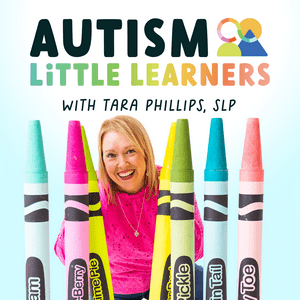155 episodes

#155 - Why Relationships Matter More Than Rewards with Dr. Barry Prizant
2025/12/30 | 1h 12 mins.
In this replay episode, I'm thrilled to bring back one of the most impactful conversations I've ever had on the podcast — my interview with Dr. Barry Prizant, world-renowned speech-language pathologist and author of the groundbreaking book Uniquely Human. Our discussion gets to the heart of why the field of autism education is shifting away from compliance-based, behavior-focused models and toward approaches rooted in compassion, emotional regulation, and trusting relationships. Dr. Prizant shares powerful insights about: ✨ understanding autistic behaviors as meaningful human responses ✨ how storytelling has shaped his work and shaped Uniquely Human ✨ why reflective practice is essential in our classrooms ✨ and how listening to autistic voices is helping reshape "what works" in autism education We also dig into topics like echolalia, the SCERTS model, relationship-based intervention, non-speaking communication, and why honoring a child's intuition and individuality is more effective—and more humane—than rigid compliance. This conversation left me feeling inspired, energized, and hopeful about where autism education is heading… and I know it will do the same for you. Bio Barry M. Prizant, PhD, CCC-SLP is recognized as among the world's leading scholars on autism and as an innovator of respectful, person- and family-centered approaches. He is Director of Childhood Communication Services, Adjunct Professor of Communicative Disorders at the University of Rhode Island, and has fifty years of experience as an international consultant and researcher. Barry has published five books, 150 articles/chapters, and is co-author of The SCERTS Model, now being implemented internationally. He was a two-time featured presenter at the UN World Autism Awareness Day, with more than 1000 presentations internationally. Barry's book Uniquely Human: A Different Way of Seeing Autism (2022) is the best-selling book on autism since 2015, published in 26 languages and ranked by Book Authority as #1 of the "100 best books on autism of all time". Barry co-hosts a podcast, Uniquely Human: The Podcast, with his friend, Dave Finch, an autistic audio engineer. Dr. Barry Prizant's Links: Website: https://barryprizant.com/ Uniquely Human Podcast: https://podcasts.apple.com/us/podcast/uniquely-human-the-podcast/id1532460901 Uniquely Human Book: https://amzn.to/4e5VWZN The Scerts Model Books: https://amzn.to/4kFpbF5 DRBI (Developmental Relationship-Based Intervention) Interview: https://podcasts.apple.com/us/podcast/uniquely-human-the-podcast/id1532460901?i=1000711834231 Autistic Self Advocacy Network (ASAN): https://autisticadvocacy.org/ Amy Laurent Ted Talk "Compliance Is Not The Goal": https://www.ted.com/talks/amy_laurent_compliance_is_not_the_goal_letting_go_of_control_and_rethinking_support_for_autistic_individuals?utm_campaign=tedspread&utm_medium=referral&utm_source=tedcomshare Thinking Person's Guide To Autism: https://thinkingautismguide.com/ David Finch Website: https://davidjfinch.com/ Ros Blackburn & Sigourney Weaver Interview: https://uniquelyhuman.com/2021/04/23/logically-illogical-an-interview-with-ros-blackburn-with-special-guest-sigourney-weaver/ Takeaways Dr. Barry Prizant brings decades of expertise in speech-language pathology, psycholinguistics, and autism advocacy — grounded in human connection, not behavior control. Uniquely Human was written to change the narrative around autism by sharing stories that center humanity, not deficits. Autistic behaviors are human responses, not symptoms to extinguish — and understanding the "why" leads to more effective and compassionate support. Emotional regulation and relationships matter more than compliance; kids cooperate when they feel safe, supported, and understood. The shift toward neurodiversity-affirming practice requires reflective practice and humility from professionals — especially when something isn't working. Evidence-based practice is broader than peer-reviewed research. It also includes family insight, lived experience, and data from everyday interactions. Parents' intuition matters, and professionals should never ask families to ignore what feels right for their child. Compliance-focused approaches often overlook emotional development, social connection, and the child's authentic voice. True support begins with trust, co-regulation, and being a calming presence when a child is overwhelmed. Listening to autistic voices is essential for shaping ethical and effective educational practices. Meaningful progress happens through everyday activities, strengths, and interests, not isolated drills. The field is moving toward relationship-based, developmental models (like SCERTS)—and that gives real hope for the future. You may also be interested in these supports Visual Support Starter Set Visual Supports Facebook Group Autism Little Learners on Instagram Autism Little Learners on Facebook

#154 Is PECS Still the Best Option? Rethinking AAC for Autistic Communicators
2025/12/23 | 54 mins.
This episode is back as a replay because the conversation is still incredibly relevant—and the questions around PECS and AAC haven't gone away. In this episode, we take a thoughtful, nuanced look at the Picture Exchange Communication System (PECS) and its role in supporting autistic communication. While PECS has been widely used for decades, growing research, lived experience, and neurodiversity-affirming practice are prompting professionals to ask deeper questions about autonomy, flexibility, and what true communication really looks like. I'm joined by speech-language pathologists Paulina Elias and Dr. Amanda Blackwell from Natural Communication for a powerful discussion about how PECS originated, what it does well, and where it can fall short—especially when communication is limited to requesting or tightly controlled exchanges. We explore why many clinicians are shifting toward multimodal, child-led AAC approaches that support regulation, self-expression, and authentic connection. You'll hear us unpack topics like honoring a child's right to say "no," moving away from hand-over-hand prompting, and choosing communication tools that grow alongside a child rather than restricting them. Whether you're a parent, educator, or therapist, this replay episode offers updated perspectives that may challenge old assumptions—and help you feel more confident in supporting communication that is respectful, functional, and truly empowering. 🎥 Watch on YouTube: https://youtu.be/Tu4rKeAM0dc 📖 Read the blog here: https://autismlittlelearners.com/pecs-autism/ Key Takeaways PECS was developed in the 1980s as a structured system rooted in behavior-based principles and primarily supports requesting. Communication is more than asking for wants—autistic children deserve access to tools that support commenting, protesting, refusing, and expressing feelings. Rigid communication systems can unintentionally limit autonomy and authentic self-expression. Hand-over-hand prompting raises concerns about consent and agency; hand-under-hand support allows for greater learner control. AAC should be multimodal, flexible, and adaptable to a child's evolving communication needs. Children must have the freedom to say "no" and communicate disagreement in order for communication to be meaningful. Relationship, trust, and emotional safety are foundational to successful communication development. Communication tools should grow with the child rather than requiring a complete "switch" later on. Neurodiversity-affirming AAC honors individuality, regulation needs, and multiple communication styles. Family insight and lived experience are critical pieces of evidence-based practice. Access to AAC resources in multiple languages increases equity and meaningful participation for families. The field is moving away from rigid systems toward child-led, respectful, and empowering communication supports—and that shift matters. You may also be interested in these supports: Visual Support Starter Set Visual Supports Facebook Group Autism Little Learners on Instagram Autism Little Learners on Facebook

#153 - Understanding Pathological Demand Avoidance (PDA) with Dr. Taylor Day
2025/12/16 | 43 mins.
This episode is back by popular demand—and for good reason. One of the most requested and talked-about conversations on The Autism Little Learners Podcast, this replay dives into Pathological Demand Avoidance (PDA) with licensed psychologist Dr. Taylor Day. In this episode, we explore PDA as a profile within autism, with a strong focus on nervous system differences, autonomy, and the fight-or-flight response. Dr. Tay shares why traditional behavior-based approaches often miss the mark for children with PDA and offers compassionate, practical insights for parents and educators who want to support children in ways that truly work. If you're navigating intense demand avoidance, burnout, or power struggles—or supporting a child who needs a more flexible, relationship-based approach—this conversation is a must-listen (or re-listen). 🎥 Watch on YouTube: https://youtu.be/htWAXEnkyzE?si=s9tYLCnIbdt4LDOy 📖 Read the blog here: https://autismlittlelearners.com/pathological-demand-avoidance/ Links: Dr. Tay's Instagram: https://www.instagram.com/the.dr.tay/ Dr. Tay's Website: https://drtaylorday.com Evolve Podcast: https://podcasts.apple.com/us/podcast/evolve-with-dr-tay-the-podcast-for-parents-of-autistic-kids/id1659784037 Takeaways PDA is not a formal diagnosis, but a commonly discussed profile within autism that centers on nervous system differences. A child's behavior often reflects a stress response, not intentional defiance. For children with PDA, autonomy is a need, not a preference. Traditional compliance-based parenting and teaching approaches often escalate challenges rather than reduce them. Understanding fight, flight, freeze, and fawn responses helps adults respond with compassion instead of control. Reducing demands can be supportive when paired with strong relationships and thoughtful boundaries. Collaboration between parents, educators, and providers leads to more consistent and effective support. Seeing the human behind the behavior shifts how we problem-solve and connect. Teaching autonomy, flexibility, and regulation skills supports long-term well-being. Offering meaningful choices can increase engagement and reduce stress. Prioritizing mastery and understanding over repetition helps children feel safe and successful. Parents are experts on their children and their insights matter. Educational systems work best when they adapt to children—not the other way around. Connection, trust, and felt safety are foundational for learning and growth. You may also be interested in these supports: Visual Support Starter Set Visual Supports Facebook Group Autism Little Learners on Instagram Autism Little Learners on Facebook

#152 - How to Explain Autism to Children: Neuro-Affirming Tips from an Autistic SLP
2025/12/09 | 50 mins.
Have you ever wondered how to talk to children about autism in a way that feels natural, positive, and empowering? In this replay episode, I'm bringing back my incredibly insightful conversation with Andi Putt (Mrs. Speechie P) — an Autistic SLP who specializes in autism evaluations and neuro-affirming support. Andi shares compassionate, practical ways to talk to autistic children about their identity, how to approach conversations with peers and siblings, and why starting these discussions early can make a profound impact on a child's confidence, self-understanding, and mental health. We also dive into how to use everyday moments to normalize autism, reduce stigma, and help all children grow in empathy and acceptance. This is one of those episodes that educators and families continuously return to… and for good reason. Takeaways Why conversations about autism should start early — and continue over time How explaining autism positively can support a child's self-concept and emotional well-being Simple, child-friendly ways to describe autism using strengths-based language Strategies for helping peers understand behaviors through empathy (including Andi's amazing "bear in the classroom" analogy) How open discussions reduce stigma, prevent bullying, and foster more inclusive classrooms Why kids are often more accepting and adaptable than adults assume How to avoid common mistakes adults make when talking about autism — and what to say instead The power of validating children's needs, identities, and differences without shame The importance of individualized support and asking children what they prefer or need How to talk about stimming, sensory overload, fight-or-flight responses, and regulation in ways young kids can understand Tips for sharing information with classmates (and when parent/child permission is needed) Bio: Andi Putt, also known as Mrs. Speechie P, is an Autistic Speech Language Pathologist specializing in team-based Autism evaluations and neuro-affirming support. She is dedicated to empowering families and helping Autistic children understand and embrace their authentic selves while also advocating for each individual's unique needs. When she's not advocating for others, you can find her indulging in a good book, planning her next travel adventure, procrastinating literally anything, or enjoying time with her family. Links: Andi's website: https://www.mrsspeechiep.com/ Andi's resources for talking to children about autism: https://www.mrsspeechiep.com/shop-all Andi's IG account (@mrsspeechiep): https://www.instagram.com/mrsspeechiep/?hl=en Watch the YouTube version of this podcast episode here: https://youtu.be/8YA5QELKAnc?si=CcMulQitmKXs-Yfi You may also be interested in these supports: Visual Support Starter Set Visual Supports Facebook Group Autism Little Learners on Instagram Autism Little Learners on Facebook

#151 Why Connection Comes First for Autistic Kids
2025/12/02 | 18 mins.
In today's episode of The Autism Little Learners Podcast, I'm diving into one of the most meaningful parts of working with autistic preschoolers: connection. When we lead with compassion, honor sensory needs, and truly celebrate each child's unique way of being, we create the emotional safety that helps them learn, communicate, and thrive. I'm sharing why stepping out of "teacher mode," validating autistic play, and tapping into deep interests are essential for forming authentic relationships. If you're ready for simple, practical strategies that build trust, reduce overwhelm, and create joyful, neuroaffirming classrooms and homes, this episode is for you. Building authentic connection creates a sense of emotional safety for autistic children. Sensory and regulation needs must be supported before meaningful connection can occur. A calm, steady adult presence helps children co-regulate and learn what regulation feels like. Stepping out of "teacher mode" makes connection more natural and less overwhelming. Autistic play is meaningful, valid, and should be honored rather than redirected. Deep interests are powerful bridges for building trust, engagement, and communication. Leading with compassion instead of compliance helps children feel seen, respected, and safe. Joyful, neuroaffirming environments increase engagement and support learning. Presuming competence communicates respect for all forms of communication and autonomy. Prioritizing connection has long-term positive effects on confidence, engagement, and overall development. Links & Related Podcast Episodes Episode 90: Autism & Play Culture with Dr. Pamela Wolfberg: https://podcasts.apple.com/us/podcast/the-autism-little-learners-podcast/id1665404820?i=1000671411034 Blog: Strength-Based Approach For Teaching Autistic Children: https://autismlittlelearners.com/strength-based-approach/ Barry Prizant's book (Uniquely Human): https://amzn.to/3MjnpgF You may also be interested in these supports: Visual Support Starter Set Visual Supports Facebook Group Autism Little Learners on Instagram Autism Little Learners on Facebook
More Education podcasts
Trending Education podcasts
About The Autism Little Learners Podcast
Listen to The Autism Little Learners Podcast, SOLVED with Mark Manson and many other podcasts from around the world with the radio.net app

Get the free radio.net app
- Stations and podcasts to bookmark
- Stream via Wi-Fi or Bluetooth
- Supports Carplay & Android Auto
- Many other app features
Get the free radio.net app
- Stations and podcasts to bookmark
- Stream via Wi-Fi or Bluetooth
- Supports Carplay & Android Auto
- Many other app features


The Autism Little Learners Podcast
download the app,
start listening.






































